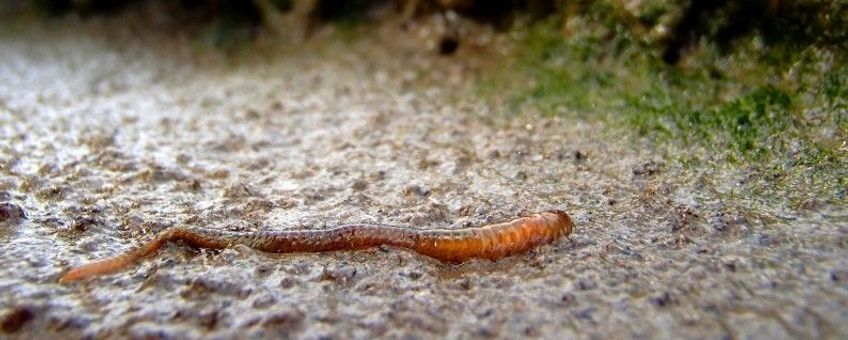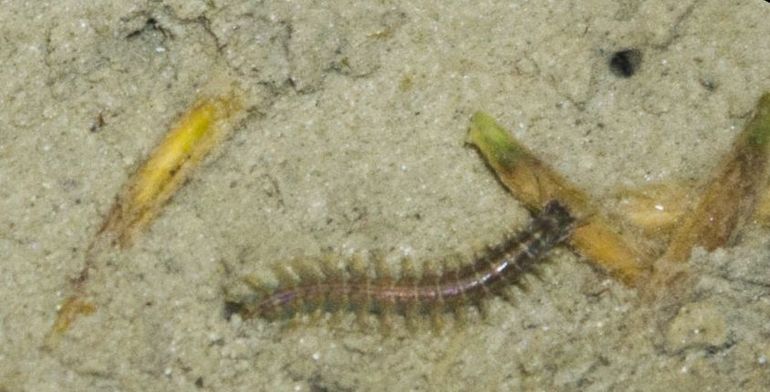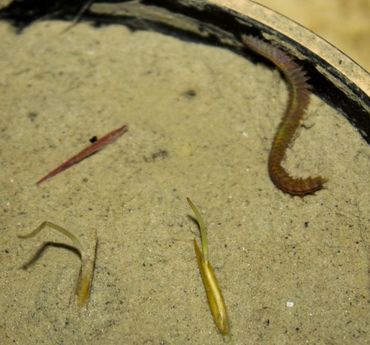
Gardening in the mud: Ragworms sprout cached seeds to get a more nutritious meal
NIOZ Royal Netherlands Institute for Sea ResearchThis is what researchers of NIOZ, Deltares and the Japanese company TechnoSuruga Laboratory Co., Ltd. discovered. Worms that grew on this ‘star diet’ of sprouts became 20% heavier than worms that were fed on their basic diet.
The ragworm Hediste diversicolor is a marine species living in the sediments of intertidal flats and pioneer zones of tidal marshes along the coasts of the North-Atlantic. Earlier research revealed that these worms can play a key role in the dispersal and distribution of seeds from coastal plants, like common cordgrass (Spartina anglica). The worms cache these seeds in their burrows, thereby preventing the seeds to be flushed from the tidal flat when the seawater ebbs.

Gardening for 'superfood'
 "But, ragworms go one step further", says NIOZ researcher Zhenchang Zhu: " They germinate the cached seeds first before they eat them. These sprouts are a high quality supplement to their basic diet, which normally consists of low-grade vegetable and animal waste material (detritus). Seeds are much more nutritious, but difficult to eat for the worms due to the large size and thick seed coat. However, this problem is solved after germination as the sprouts are juicy and easy to digest.” Zhenchang Zhu adds: "Until now this practice was only known from people. For centuries, bean sprouts and cress have been part of the diet of people in East Asia. Currently, the sprouted food is becoming quite popular in the West as a ‘superfood’ because it contains high levels of proteins and vitamins. The seedlings of the cord grass can be regarded as superfood for the ragworms as well. In our laboratory study, worms who were fed on sprouts became 20% heavier than the worms that were fed on detritus.”
"But, ragworms go one step further", says NIOZ researcher Zhenchang Zhu: " They germinate the cached seeds first before they eat them. These sprouts are a high quality supplement to their basic diet, which normally consists of low-grade vegetable and animal waste material (detritus). Seeds are much more nutritious, but difficult to eat for the worms due to the large size and thick seed coat. However, this problem is solved after germination as the sprouts are juicy and easy to digest.” Zhenchang Zhu adds: "Until now this practice was only known from people. For centuries, bean sprouts and cress have been part of the diet of people in East Asia. Currently, the sprouted food is becoming quite popular in the West as a ‘superfood’ because it contains high levels of proteins and vitamins. The seedlings of the cord grass can be regarded as superfood for the ragworms as well. In our laboratory study, worms who were fed on sprouts became 20% heavier than the worms that were fed on detritus.”
The scientific results are published in the scientific journal 'Ecology'. Moreover, the magazine ‘New Scientist’ devoted a news item to this subject in its weekly 'zoologger' blog.
Text: NIOZ
Photos: Jim van Belzen (leadphoto: A ragworm Hediste (Nereis) diversicolor in its element on an intertidal flat); Zhenchang Zhu
